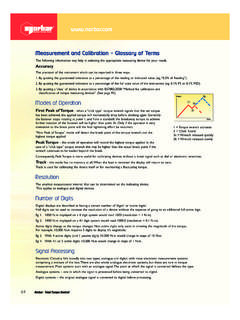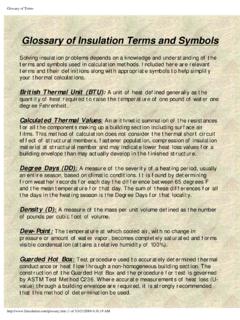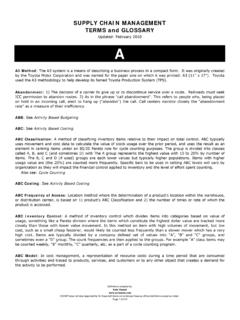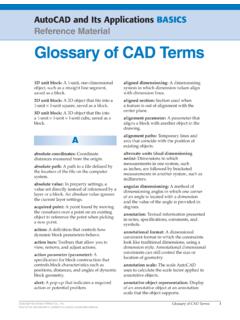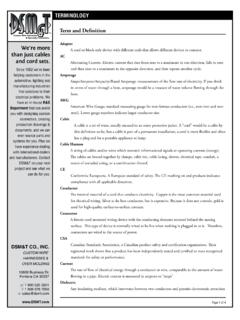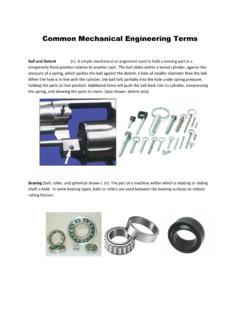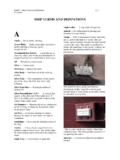Transcription of GLOSSARY OF STONE INDUSTRY TERMS
1 2007 Marble Institute of America GLOSSARY Page 23-1 GLOSSARY OF STONE INDUSTRY TERMS Additional references are listed at the end of this GLOSSARY . A abrasive finish A flat and nonreflective surface finish. abrasive hardness (Ha) A measure of the wearing qualities of STONE for floors, stair treads, and other areas subjected to abrasion by foot traffic. Refer to ASTM C241. absorption Percentage of moisture absorbed by weight. Refer to ASTM C97. acid wash A treatment applied to the face of a STONE to achieve a texture or finish that is distressed. Chemical treatments are more effective when applied to calcareous stones than to siliceous STONE types. Recently, the use of acid and other types of chemical treatments has lessened due to environmental and disposal concerns.
2 Chemical processes have been replaced by mechanical methods for the texturing of the STONE face. adhered Secured and supported by adhesion of an approved bonding material over an approved backing; is used in reference to STONE veneer. adoquin A volcanic, quartz-based STONE containing a variety of colored aggregates and pumice in a quartz matrix. Quarried in Mexico. Available in several colors. agglomerated STONE A manmade product composed of crushed STONE combined with resin. alabaster A fine-grained and translucent variety of gypsum, generally white in color. May be cut and carved easily with a knife or saw. Term is often incorrectly applied to fine-grained marble. alkaline Pertains to a highly basic, as opposed to acidic, substance; for example, hydrogen or carbonate of sodium or potassium.
3 Anchor A metal fastener used for securing dimension STONE to a structure. Anchor types for stonework include those made of flat stock (strap, cramps, dovetails, dowel, strap and dowel, and two-way anchors) and round stock (rod cramp, rod anchor, eyebolt and dowel, flat-hood wall tie and dowel, dowel and wire toggle bolts). anchorage The means by which slabs are attached to a self-supporting structure. antique finish A finish that replicates rusticated or distressed textures. Produced through mechanical or chemical means to simulate the naturally occurring effects of the aging process. apron A trim piece under a projecting STONE top, stool, etc. arch The curved or pointed construction over a doorway or opening.
4 Arch shapes range from flat to semicircular or semi-elliptical to acutely pointed. architrave 1. The beam or lowest division of the entablature in the classical orders, spanning from column to column. 2. The decorated surrounds of a window or door at the head and jamb. arkose A sandstone containing 10% or more clastic grains of feldspar. Also called arkosic sandstone, feldspathic sandstone. arris An edge or angle where two surfaces meet; for example, moldings and raised edges. Page 23-2 GLOSSARY 2007 Marble Institute of America ashlar A thin, dressed STONE cut in square or rectangular shapes, typically used as a wall facing in a pattern of varying shapes and sizes. ASI (Allied STONE Industries) The Allied STONE Industries is made up of STONE quarriers, fabricators, and the suppliers of natural building materials and related machinery and tools.
5 B back-buttering The process of slathering the back of a STONE tile with thinset material in order to ensure proper mortar coverage. This prevents hollow areas and subsequent future cracking of tiles. Also helpful to ensure a level installation. backing rod A flexible and compressible type of closed-cell foam polyethylene, butyl rubber, or open-cell or closed-cell polyurethane, rounded at surface to contact sealant. It is installed at the bottom or rear of a joint. Often described as a filler strip. backsplash The area located between the countertop and lower cabinet. Normally 16-18 inches in height. baluster A short post or vertical member in a series that supports a railing or coping, thus forming a balustrade.
6 May be curved or straight. balustrade An entire railing system with top rail and balusters, and sometimes including a bottom rail. banker Bench of timber or STONE (may be a single block) on which STONE is worked. basalt A dark-colored, igneous rock commercially known as granite when fabricated as dimension STONE . base The bottom course of a STONE wall, or the vertical first member above grade of a finished floor. bearing check A slot cut into the back of dimension STONE to allow entry of a supporting angle or clip. bed 1. The top or bottom of a joint, natural bed; surface of STONE parallel to its stratification. 2. In granites and marbles, a layer or sheet of the rock mass that is horizontal, commonly curved and lenticular, as developed by fractures.
7 Sometimes also applied to the surface of parting between rock sheets. 3. In stratified rocks, the unit layer formed by sedimentation; of variable thickness, and commonly tilted or distorted by subsequent deformation. It generally develops a rock cleavage, parting, or jointing along the planes of stratification. bed joint A horizontal joint between stones , usually filled with mortar, lead, or sealant. belt course A continuous horizontal course, marking a division in the wall plane. bevel A sloped surface contiguous with a vertical or horizontal surface. bleed Staining caused by corrosive metals, oil-based putties, mastics, caulking, or sealing compounds. blending The proper positioning of adjacent veneer panels, floor slabs, or tiles, by their predominant color.
8 Block See quarry block. block cutter A machine used in the quarrying process for in-line drilling of small diameter holes. bluestone A fine- to medium-grain, metamorphic, quartz-based STONE of the Appalachian Plateau and other regions of the world. Formed in the Devonian Period, the upper STONE is green and lilac in color, while the middle STONE is dark gray and blue. 2007 Marble Institute of America GLOSSARY Page 23-3 bollard A tree-standing STONE post or guard. bond 1. Overlapping of joints in successive courses. 2. To stick or adhere. book match pattern A layout in pairs of all STONE elements to confirm that the design matches. bowing A warping or curving of the wall cladding.
9 Brecciated marble Any marble composed of angular fragments. brownstone A trade term applied to ferruginous dark brown and reddish-brown askosic quartz-based STONE extensively used for construction in the during the 19th century. STONE for New York City s noted brownstone fronts came from the Connecticut Valley in Massachusetts, southeastern Pennsylvania, and New Jersey. brushed finish Obtained by brushing a STONE with a coarse rotary-type wire brush. BSI (Building STONE Institute) A trade association, founded in 1919, of quarriers, fabricators, dealers, and others working with natural STONE . Sponsor of the Tucker Architectural Awards. bullnose Convex rounding of a STONE member, such as a stair tread.
10 Bush hammering A mechanical process which produces textured surfaces that vary from subtle to rough. buttering Placing mortar on STONE units with a trowel before setting them into position. butt joint An external corner formed by two STONE panels with one head. C calcareous Refers to substances containing or composed of calcium carbonate. calcite A crystalline variety of limestone containing not more than 5% magnesium carbonate. calcite streaks Description of a white or milky streak occurring in STONE . It is a joint plane usually wider than a glass seam which has been recemented by deposition of calcite in the crack. It is structurally sound. calibration The first step in the finishing process of a STONE tile.
